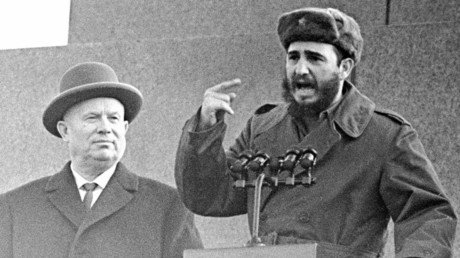Fidel Castro, Cuba’s longtime leader, dies at 90
After years of dealing with failing health, Fidel Castro, leader of the Cuban revolution who steered the country through decades of a US economic blockade, has died, state media report.
Castro died in Havana on Friday at 10:29pm local time, Cuban television said. His death was announced by his brother Raul, who took the reins after Fidel stepped down.
“According to the will expressed by comrade Fidel, his body will be cremated", Raul said.
Castro led the country from 1959 to 2006, when an intestinal condition nearly led to his death. He ceded power to his brother first provisionally, and then formally in 2008. In his last years, he mostly stayed out of the public eye, only occasionally providing commentary on events in Cuba.
His passing marks the end of an era for many. Castro was the last remaining leader from the group of old school communist leaders including Chinese Mao Zedong, Korean Kim Il-sung and Soviets Nikita Khrushchev and Leonid Brezhnev.
Dictator or national hero, Castro was called many things along the way, as he rose from being a student activist protesting against oppressive regimes to becoming the president of Cuba.
In February 1959, the Cuban Revolution brought Castro to power as the prime minister. He was backed by the so-called 26th of July Movement, and Latin American revolutionary Che Guevara. Together, they managed to oust US-backed President Batista.
After failing to maintain ties with Washington, Cuba became isolated from its neighbor as the US chose to cut all trade links with the Caribbean state. In 1961, the island nation fended off a CIA-backed invasion known as the Bay of Pigs.
Upon taking office, Castro quickly found a new ally, as the Soviet Union supplied Cuba with arms, cars, and industrial equipment to keep it running.
But the nations’ alliance brought more than mutual benefits. Cuba and Russia became key players in the Cuban Missile Crisis – arguably the most dangerous confrontation of the Cold War, which almost ended in a nuclear show-down.
READ MORE: Fidel Castro says he’s nearing the end in farewell speech
In October 1962, Castro agreed to house Soviet nuclear missiles on Cuban territory, a move that followed the deployment of US missiles in Turkey. Washington was furious over the development, and pledged to use force if necessary to prevent it. The countries’ leaders, Kennedy and Khrushchev, eventually agreed to a compromise.
The US government has always been open about its feelings toward communist Cuba. It remains unknown how many times the CIA tried to assassinate Castro, but some Cuban officials set the number as high as 600. This figure includes the notorious incident when Castro’s cigarettes were found to be stuffed with explosives.
After passing power to his brother Raul, Fidel was still considered the main moral authority in Cuba. Occasionally, he also met with foreign dignitaries like Pope Francis in 2015 and Russian Orthodox Patriarch Kirill in February.
Under Raul’s leadership, Cuba has experienced a slow transformation as he has introduced some market-style economic reforms in the largely socialist country. He also agreed to restore diplomatic ties with the United States in December, taking a step away from decades of rivalry. Fidel was skeptical about the rapprochement, but did not oppose it.













